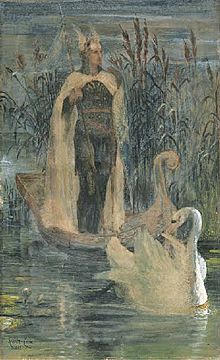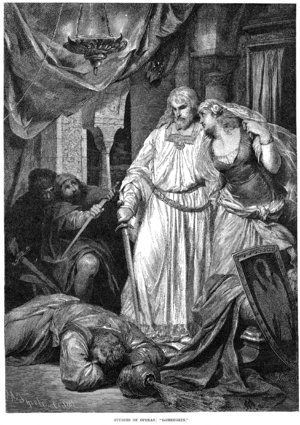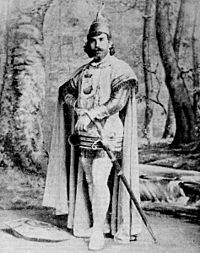Lohengrin (opera) facts for kids
Quick facts for kids |
|
|---|---|
| by Richard Wagner | |

Wagner, ca. 1840
|
|
| Genre | Opera in 3 acts |
| Native title | Lohengrin |
| Librettist | Richard Wagner |
| Language | German |
| Based on | German legend |
| Premiere | Weimar, Germany 28 August 1850 |
Lohengrin is an opera in three acts by Richard Wagner. Wagner wrote both the words and the music. It is based on an old German legend.
Origins of the story
Lohengrin is a story written by an unknown German author. It is related to other stories that belong to the Knight of the Swan tradition.
Wagner’s opera is like a fairy tale. It immediately became very popular. The young King Ludwig II of Bavaria built a fairy-tale castle in the south of Germany and called it "Neuschwanstein," meaning: “New Swan Stone”. The King was very fond of Wagner’s music and gave him a lot of money to help him with his next operas, especially for the cycle known as the Ring of the Nibelung.
It was first performed in Weimar, Germany on 28 August 1850 with Franz Liszt conducting. Liszt chose to conduct it on that particular day because 28 August was the birthday of Johann Wolfgang von Goethe who had lived in Weimar.
Wagner did not hear the first performance. In May 1849 he had run away from Germany because he had been involved in a revolution. He fled to Switzerland. He did not hear his opera Lohengrin until 15 May 1861 when he saw a performance in Vienna.
Roles
| Role | Voice type | Premiere Cast, 28 August 1850 (Conductor: Franz Liszt) |
|---|---|---|
| Lohengrin | tenor | Carl Beck |
| Elsa of Brabant | soprano | Rosa von Milde-Agthe |
| Ortrud, Telramund's wife | mezzo-soprano | Fastlinger |
| Friedrich of Telramund, a Count of Brabant | baritone | Hans von Milde |
| Heinrich der Vogler (Henry the Fowler) | bass | Höfer |
| The King's Herald | baritone | August Pätsch |
| Four Noblemen of Brabant | tenors, basses | |
| Four Pages | sopranos, altos | |
| Duke Gottfried, Elsa's brother | silent | Hellstedt |
| Saxon, Thuringian, and Brabantian counts and nobles, ladies of honor, pages, vassals, serfs | ||
The story
- Place: The story takes place in Antwerp (in today’s Belgium), on the river Scheldt.
- Time: 10th century
Act 1
The opera starts with a prelude played by the orchestra. It describes an angel coming down from the sky with the Holy Grail.
King Henry the Fowler has arrived in Brabant. He is sitting by the banks of the river Scheldt. Around him are Counts and nobles of the Saxon army. Opposite them are Counts and nobles of Brabant. King Henry explains that he had been fighting Hungarians who came to invade his country. They had agreed not to fight for nine years, but these nine years were now coming to an end and his men would have to fight again. The King wants the Brabantines to help them. He asks one of their bravest knights, Friedrich von Telramund, to explain why the Brabantines are arguing amongst themselves.
Count Telramund explains that the Duke of Brabant had recently died. As he lay dying, he had asked Telramund to look after his daughter Elsa and his son Gottfried. One day the two children had gone into the forest and Elsa had returned alone. The Duke tried to find out what had happened to Gottfried. The Duke’s wife Ortrud persuades the Duke to accuse Elsa of murdering her brother. The duke then makes himself the king of Brabant.
Elsa knows that she is innocent and asks God to be her judge. She needs a knight to fight for her. Telramund agrees to fight him.
The second time that the Herald calls the unknown knight, a miracle happens. A boat, pulled by a swan, appears. A knight in shining armour stands in the boat. He gets out of the boat, tells the swan that it can go, and then he greets the king. He asks Elsa if he can be her knight. Elsa kneels in front of him and asks for his help. He says that he will serve her, but he asks one thing: that she should never ask him what his name is or where he comes from. Elsa agrees. Everyone, except for Ortrud, prays and the fight starts. The unknown knight wins, but then he spares Telramund’s life. The unknown knight now takes Elsa’s hand and asks her to marry him.
Act 2
The action takes place in the courtyard outside the cathedral. It is night. Telramund and Ortrud have been told to go away. Ortrud is a heathen witch, the daughter of Radbod, the Duke of Frisia. She tries to make Telramund brave again. She is going to persuade Elsa to ask the unknown knight what is name is.
When Elsa comes onto the balcony in the morning she sees Ortrud and feels sorry for her. An announcement is made that the king has decided to give the unnamed knight the title of Duke of Brabant. He says he does not want the title, and prefers to be known just as "Guardian of Brabant."
The King, the Knight, Elsa and her attendants are about to go into the church. Ortrud, beautifully dressed, appears and says that the knight is a magician. Telramund appears and says that the result of the fight he had did not count, because the knight has not told his name. The knight still refuses to tell his name.
Act 3
The bedroom of the young couple. Elsa and her new husband enter to the well-known music called the Bridal Chorus. The couple say they love one another. However, Elsa still remembers how Ortrud was pressing her to ask the Knight his name. She asks him who he is. Telramund and four of his friends rush into the room to attack the knight, but Telramund is killed instead. The Knight is very sad and tells Elsa they will now go to the King and he will tell him who he is.
The scene changes to the banks of the river, as in Act I. The army is ready for war. Telramund’s dead body is carried in. The Knight explains why he killed Telramund. He tells the story of the Holy Grail and says that he is Lohengrin, Knight of the Holy Grail and son of King Parsifal. He says that he now has to return to his home. He had only stayed so long so that he could prove that Elsa was innocent.
Sadly he says goodbye to his young wife. The swan comes again. Lohengrin prays that Elsa may get her lost brother back. The swan dives into the river and appears again in the form of Gottfried, Elsa’s brother. He had been turned into a swan by the evil magic of Ortrud.
A dove comes down from heaven, and takes the place of the swan at the head of the boat. It takes Lohengrin to the castle of the Holy Grail. Elsa is so upset that she dies.
"Wagner Nights" by Ernest Newman (1949)
Images for kids
See also
 In Spanish: Lohengrin para niños
In Spanish: Lohengrin para niños




